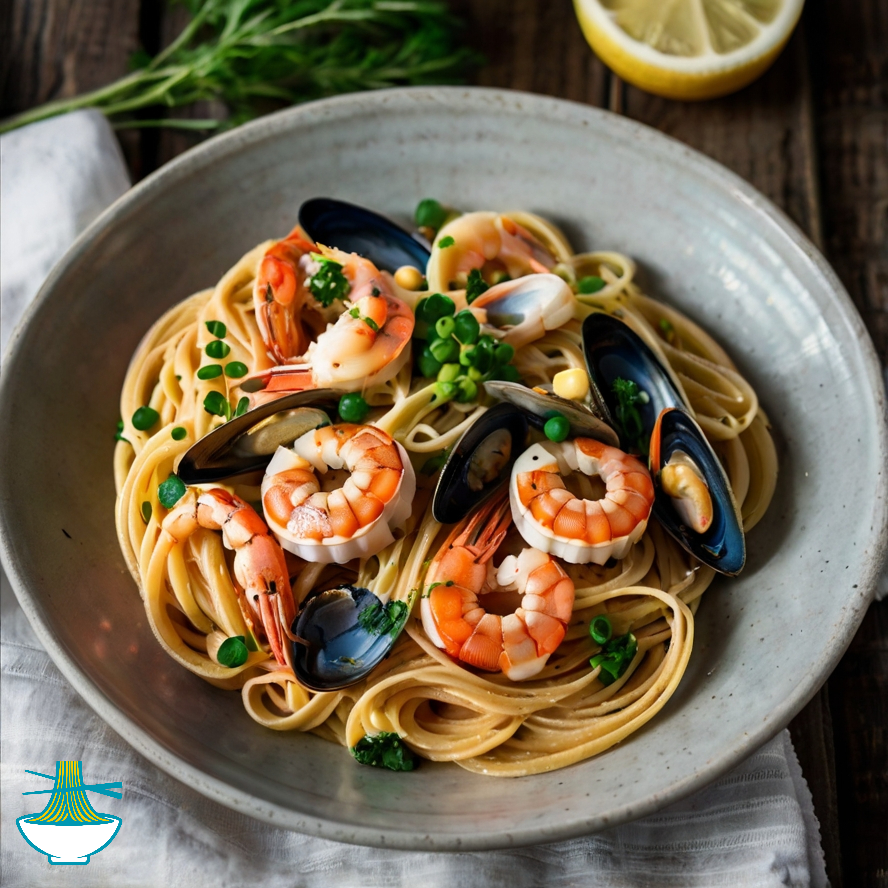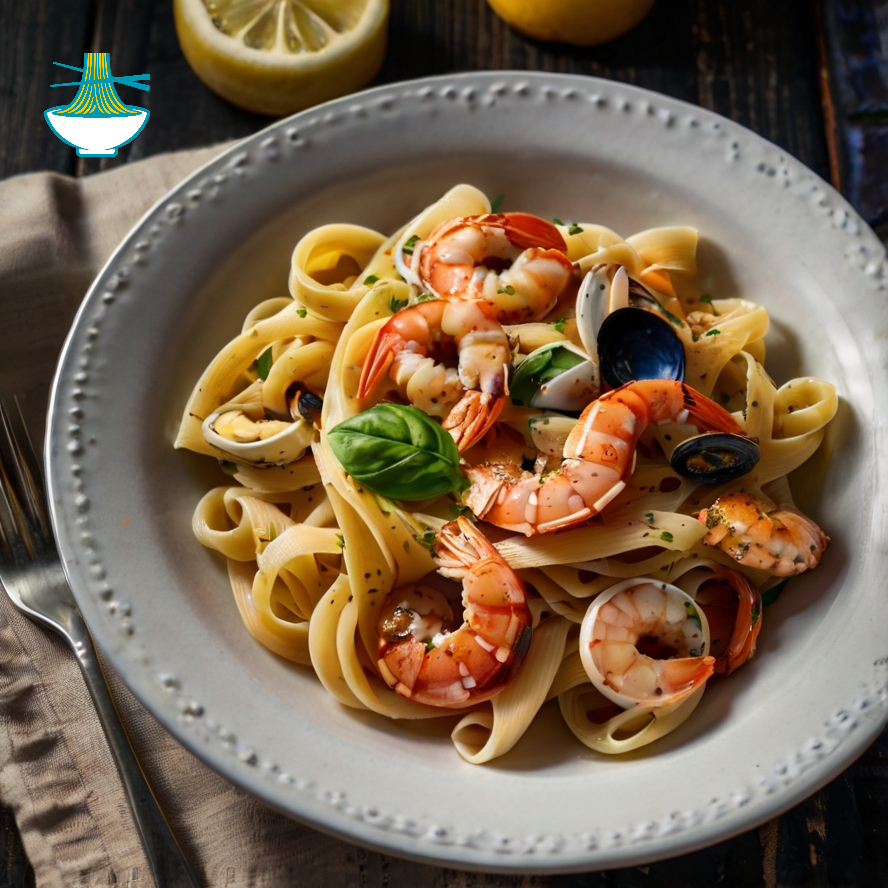Seafood Pasta is a culinary delight that pairs tender pasta with a medley of fresh seafood, creating a dish rich in flavor and nutrients. Seafood provides high-quality protein and is an excellent source of omega-3 fatty acids, which support heart health and brain function. Additionally, it offers essential vitamins and minerals like vitamin D, selenium, and iodine, which promote bone health, immune function, and thyroid regulation. The pasta adds energy-boosting carbohydrates, making this dish both satisfying and nourishing. Whether enjoyed as a main course or a celebratory meal, Seafood Pasta is a versatile and healthful choice.
Ingredients:
- 300g (10.5 oz) pasta (spaghetti, linguine, or penne)
- 200g (7 oz) shrimp, peeled and deveined
- 200g (7 oz) scallops
- 200g (7 oz) mussels, cleaned
- 2 tablespoons olive oil
- 3 garlic cloves, minced
- 1 cup cherry tomatoes, halved
- 1/2 cup dry white wine
- 1/2 cup seafood stock
- 1 teaspoon red pepper flakes (optional)
- Salt and pepper to taste
- Fresh parsley, chopped, for garnish
Instructions:
Cook the Pasta:
- Bring a large pot of salted water to a boil. Add the pasta and cook according to the package instructions until al dente, about 8-10 minutes. Drain the pasta, reserving about 1 cup of the pasta cooking water. Set the cooked pasta aside.
Prepare the Seafood:
- While the pasta is cooking, heat 2 tablespoons of olive oil in a large skillet over medium heat. Add the minced garlic and sauté for about 1-2 minutes, or until fragrant and golden.
Cook the Shrimp, Scallops, and Mussels:
- Add the shrimp, scallops, and mussels to the skillet. Cook for 3-5 minutes, turning the seafood occasionally until it becomes opaque and cooked through. Once done, remove the seafood from the skillet and set it aside.
Cook the Cherry Tomatoes:
- In the same skillet, add the cherry tomatoes and cook for 2-3 minutes, or until they begin to soften and burst. Stir occasionally to avoid burning.
Deglaze the Pan:
- Pour in the white wine and seafood stock. Scrape the bottom of the skillet with a wooden spoon to deglaze and lift any flavorful bits stuck to the pan. Allow the mixture to simmer for about 5 minutes, or until it has reduced slightly.
Return the Seafood to the Skillet:
- Once the sauce has simmered, return the cooked shrimp, scallops, and mussels to the skillet. Toss everything together to coat the seafood in the sauce. Season with red pepper flakes, salt, and freshly ground black pepper to taste.
Combine with Pasta:
- Add the cooked pasta to the skillet with the seafood and sauce. Toss everything together, adding a little of the reserved pasta water if the sauce seems too thick. Continue tossing until the pasta is well coated and the seafood is evenly distributed.
Serve:
- Once everything is combined, serve the dish immediately. Garnish with fresh herbs such as parsley or basil for added flavor and a pop of color. Enjoy!
Nutritional Insights on Specific Types of Seafood
Seafood offers a wide variety of options, each with unique nutritional benefits. For example:
- Shrimp: Shrimp is a low-calorie, high-protein option that provides a good source of omega-3 fatty acids. It’s a versatile seafood that can be swapped with fish like tuna, cod, or halibut if preferred.
- Scallops: Scallops are a lean source of protein and are rich in vitamin B12, which helps in the formation of red blood cells and supports the nervous system. They also contain magnesium, which helps maintain muscle and nerve function.
- Mussels: Mussels are an excellent source of iron, which is essential for oxygen transport in the blood. They also provide a significant amount of vitamin C, which supports the immune system and skin health.
Alternative Seafood Options:
- Fish (like Salmon or Cod): If you don’t like shellfish or have allergies, fish can easily replace the shrimp, scallops, or mussels. Fish like salmon also provides omega-3s, which are beneficial for heart health.
Tips for Faster Preparation
For those looking to prepare this dish quickly, here are some helpful tips:
- Use Pre-cooked Seafood: If you're short on time, you can use pre-cooked shrimp or canned mussels, which cut down on cooking time significantly.
- Pre-chopped Vegetables: Opt for pre-chopped vegetables, such as tomatoes and garlic, available in most grocery stores.
- Don’t Overcook Seafood: Overcooking seafood can result in a rubbery texture. To save time and preserve the tenderness of the seafood, cook it just until it turns opaque.
Adapting the Recipe for Various Diets
Seafood pasta is a versatile dish, and it can be adapted to suit various dietary needs:
- Low-Carb/Keto Diet: Replace the pasta with zucchini noodles or shirataki noodles to keep the dish low in carbs.
- Vegetarian Version: Swap the seafood for plant-based protein sources like tofu or tempeh, and use vegetable broth instead of seafood stock for a vegetarian-friendly version.
- Gluten-Free: Use gluten-free pasta options, such as rice pasta or corn pasta, to accommodate those with gluten sensitivities.
Frequently Asked Questions (FAQ)
1. What are the general health benefits of seafood? Seafood is an excellent source of high-quality protein, omega-3 fatty acids, and essential vitamins and minerals. It helps in reducing the risk of heart disease, promotes brain health, boosts the immune system, and improves skin health. Omega-3 fatty acids, in particular, are known for their anti-inflammatory properties and their ability to support cognitive function.
2. Can I replace the ingredients in this recipe? Yes, there are many ways to substitute ingredients based on personal preferences or dietary restrictions:
- You can replace the seafood with other protein sources, such as chicken, turkey, or plant-based proteins.
- If you have seafood allergies, you can substitute the seafood with firm fish like tuna or cod.
- For a vegetarian version, replace seafood with tofu or tempeh and use vegetable stock instead of seafood stock.
3. What is the recommended serving size for this dish? This dish is typically served as a main course, with a recommended serving size of about 1 to 1.5 cups of pasta per person. It’s a filling dish, so it works well as a complete meal on its own.
4. Can I prepare this dish in advance? Seafood pasta is best enjoyed fresh to preserve the texture and flavor of the seafood. However, if you want to prepare it ahead of time, you can cook the seafood and pasta separately and combine them just before serving. The seafood can be refrigerated for up to 1 day, but it’s best not to reheat it too much to avoid overcooking.
Nutritional Values and Benefits
1. Pasta (300g)
- Calories: 1050
- Carbohydrates: 210g
- Protein: 36g
Nutritional Benefit: Pasta provides energy-boosting carbohydrates and some protein, making it a great base for this dish.
2. Shrimp (200g)
- Calories: 160
- Protein: 38g
- Omega-3 Fatty Acids: 300mg
Nutritional Benefit: Shrimp is high in protein and low in fat, with omega-3s that support heart and brain health.
3. Scallops (200g)
- Calories: 180
- Protein: 36g
- Vitamin B12: 1.5mcg (60% DV)
Nutritional Benefit: Scallops are a lean source of protein and rich in vitamin B12, essential for energy production.
4. Mussels (200g)
- Calories: 150
- Protein: 20g
- Iron: 5mg (28% DV)
Nutritional Benefit: Mussels provide iron for oxygen transport and are a good source of selenium and zinc for immune support.
5. Olive Oil (2 tablespoons)
- Calories: 240
- Fat: 27g
Nutritional Benefit: Olive oil is rich in healthy monounsaturated fats, supporting heart health.
6. Garlic (3 cloves)
- Calories: 13
Nutritional Benefit: Garlic contains allicin, which has antibacterial and heart-healthy properties.
7. Cherry Tomatoes (1 cup)
- Calories: 30
- Vitamin C: 20mg (33% DV)
Nutritional Benefit: Tomatoes are rich in vitamin C and antioxidants that support skin and immune health.
8. White Wine (1/2 cup)
- Calories: 100
Nutritional Benefit: Adds flavor; moderate amounts of wine antioxidants may support heart health.
9. Seafood Stock (1/2 cup)
- Calories: 20
Nutritional Benefit: Enhances flavor while contributing minerals like iodine and calcium.
10. Red Pepper Flakes (1 teaspoon)
- Calories: 5
Nutritional Benefit: Adds spice and contains capsaicin, which boosts metabolism.
11. Parsley (1 tablespoon)
- Calories: 2
Nutritional Benefit: High in vitamin K, supporting bone and blood health.
Merged Nutritional Benefits: Seafood Pasta is a nutrient-rich dish that offers lean protein, omega-3 fatty acids, and essential vitamins and minerals. The seafood promotes heart, brain, and immune health, while the pasta provides sustained energy. The olive oil and tomatoes contribute antioxidants and healthy fats, making this dish both delicious and nourishing.
Health Benefits
The ingredients in the Seafood Pasta dish offer a variety of health benefits that can be elaborated upon to emphasize their nutritional value:
- Omega-3 Fatty Acids in Seafood: Seafood, especially fish like salmon, mackerel, and sardines, is rich in omega-3 fatty acids. Omega-3s have been shown to reduce inflammation, lower the risk of heart disease, and improve brain function. Omega-3 fatty acids also support skin health, promoting hydration and reducing the appearance of fine lines and wrinkles.
- Benefits of Garlic: Garlic is a powerful antioxidant that contains allicin, which has been shown to reduce blood pressure and cholesterol levels, support immune function, and even have antibacterial properties. Regular consumption of garlic may help in preventing common colds and improving overall health.
- Seafood’s Role in Skin and Immune Health: The seafood in this dish (shrimp, scallops, and mussels) is packed with vitamins and minerals like vitamin B12, zinc, and selenium, which support healthy skin and a strong immune system. Selenium, in particular, is an antioxidant that helps protect the body from oxidative stress and supports thyroid function.


Comments